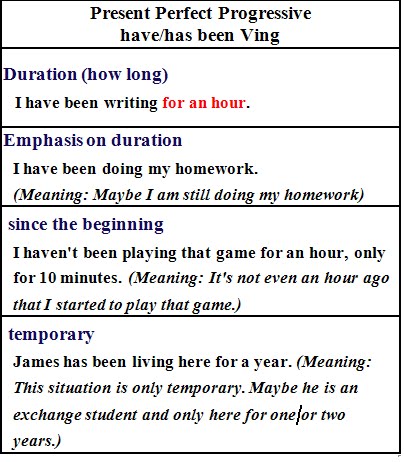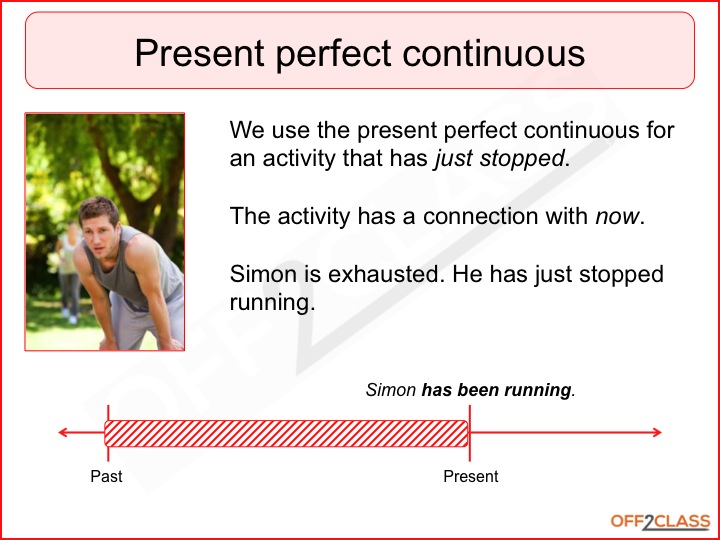Idioma Present perfect (Presente perfecto) & Present perfect cntinuous
-
AutoBanned

 Present perfect (Presente perfecto) & Present perfect cntinuous
Present perfect (Presente perfecto) & Present perfect cntinuous
Present perfect (Presente perfecto)
El pretérito perfecto simple expresa una acción que está todavía en curso o que se detuvo hace poco, pero tiene una influencia en el presente. Se pone énfasis en el resultado.
Para los verbos irregulares, utilice el formulario participio (ver lista de verbos irregulares , tercera columna). Para los verbos regulares, sólo tiene que añadir " ed " .Ejemplo:
Form of Present Perfect
Positive Negative ............. Question
I / you / we / they I have spoken. I have not spoken. Have I spoken?
he / she / it He has spoken. He has not spoken. Has he spoken?
Use of Present Perfect...
-puts emphasis on the result
Example: She has written five letters.
-action that is still going on
Example: School has not started yet.
-action that stopped recently
Example: She has cooked dinner.
-finished action that has an influence on the present
Example: I have lost my key.
-action that has taken place once, never or several times before the moment of speaking
Example: I have never been to Australia.
-Signal Words of Present Perfect
already, ever, just, never, not yet, so far, till now, up to now

Present perfect cntinuous(Presente perfecto continuo)


FORM
[has/have + been + present participle]
Examples:
You have been waiting here for two hours.
Have you been waiting here for two hours?
You have not been waiting here for two hours.
Complete List of Present Perfect Continuous Forms
USE 1 Duration from the Past Until Now
We use the Present Perfect Continuous to show that something started in the past and has continued up until now. "For five minutes," "for two weeks," and "since Tuesday" are all durations which can be used with the Present Perfect Continuous.
Examples:
They have been talking for the last hour.
She has been working at that company for three years.
What have you been doing for the last 30 minutes?
James has been teaching at the university since June.
We have been waiting here for over two hours!
Why has Nancy not been taking her medicine for the last three days?
USE 2 Recently, Lately
You can also use the Present Perfect Continuous WITHOUT a duration such as "for two weeks." Without the duration, the tense has a more general meaning of "lately." We often use the words "lately" or "recently" to emphasize this meaning.
Examples:
Recently, I have been feeling really tired.
She has been watching too much television lately.
Have you been exercising lately?
Mary has been feeling a little depressed.
Lisa has not been practicing her English.
What have you been doing?
IMPORTANT
Remember that the Present Perfect Continuous has the meaning of "lately" or "recently." If you use the Present Perfect Continuous in a question such as "Have you been feeling alright?", it can suggest that the person looks sick or unhealthy. A question such as "Have you been smoking?" can suggest that you smell the smoke on the person. Using this tense in a question suggests you can see, smell, hear or feel the results of the action. It is possible to insult someone by using this tense incorrectly.
REMEMBER Non-Continuous Verbs/ Mixed Verbs
It is important to remember that Non-Continuous Verbs cannot be used in any continuous tenses. Also, certain non-continuous meanings for Mixed Verbs cannot be used in continuous tenses. Instead of using Present Perfect Continuous with these verbs, you must use Present Perfect.
Examples:
Sam has been having his car for two years. Not Correct
Sam has had his car for two years. Correct
ADVERB PLACEMENT
The examples below show the placement for grammar adverbs such as: always, only, never, ever, still, just, etc.
Examples:
You have only been waiting here for one hour.
Have you only been waiting here for one hour?
ACTIVE / PASSIVE
Examples:
Recently, John has been doing the work. Active
Recently, the work has been being done by John. Passive
NOTE: Present Perfect Continuous is less commonly used in its passive form.
 Permisos de publicación
Permisos de publicación
- No puedes crear nuevos temas
- No puedes responder temas
- No puedes subir archivos adjuntos
- No puedes editar tus mensajes
-
Reglas del foro
▲
▼
Atajos de Navegación Disponibles